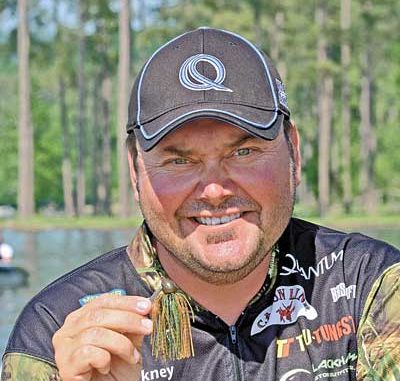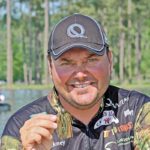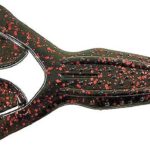
The roots of this annual event run deep.
Generally, by July, the Mississippi River will have started falling, which causes the water in the Atchafalaya River to begin falling. During the spring, the water will be high, and the bass hard to find because of the numbers of canals, natural bayous and lakes throughout the Atchafalaya Basin.
But in July, the water recedes and returns back to the manmade canals and the original lakes and bayous like draw-downs happen on a reservoir. The area where the bass live shrinks, so the bass become concentrated and much easier to find.
Throughout the spring, the bass have been living out in the woods feeding on crawfish, and now, the bass are big and healthy. The spawn has ended. At this time of year, you can catch a number of bass — perhaps 50 to 60 a day weighing 1/2 to 1 1/2 pounds each — in the Basin. You’ll have a chance to catch a 4- or 5-pounder too.
Early morning
Often there’s an abundance of vegetation in the Basin. If I’m in an area with more wood than vegetation, I’ll start fishing with a buzz bait at first light or a Strike King Spit-N-King. I love to get that early morning, topwater bite. If I’ll be fishing vegetation at first light, I’ll fish either a black or white Rage Toad. But more than likely in July, the water will be stained, and the area will have low-light conditions. Then I’ll probably start off with a black Rage Toad.
Normally I’ll fish 20-pound-test monofilament, but because numbers of other big species are in the Basin during July, I’ll be fishing 50-pound-test Cajun Braid line. I can throw this line a long distance, and I can get a good, hard, fast hookset well away from the boat.
I prefer to hold my rod tip at between an 11:00 and 12:00 position, so that I have to hesitate before I set the hook. When the bass takes the Rage Toad, I have to reel down before I set the hook, which gives the bass enough time to get the Rage Toad in its mouth.
Morning
When the Rage Toad no longer gets bites, I hunt heavy vegetation. My first choice then will be a 1/2- or 3/4-ounce Hack Attack Jig. Once the water comes out of the woods, the bass still will be feeding on crawfish, and the Hack Attack Jig with the plastic Denny Brauer chunk trailer resembles a big crawfish. By fishing the big jig with the chunk, I’ll catch bigger bass.
I start fishing the holes in the grass first. If the water’s warm, I’ll fish the 3/4-ounce Hack Attack Jig because I want the jig to fall faster than it will using the 1/2-ounce jig. If I’m fishing in hyacinths, I may switch to a 1- or 1 1/4-ounce Hack Attack Jig to punch through that heavy vegetation. Basically, I’ll drop the jig through the vegetation and then work the jig under the canopy created by the vegetation.
Many people are afraid to fish a jig in the grass because oftentimes the jig will pick up grass. I won’t tell you that the Hack Attack Jig won’t pick up grass; however, the Hack Attack Jig has been designed to go through the grass. It has a 27-degree line tie, making it the most-weedless jig on the market. I helped design this jig, so I not only can pitch it into heavy brushpiles but also fish it in the grass in the Atchafalaya Basin. I like to fish heavy-grass cover when I can, and the Basin gives me plenty of grass to fish.
My favorite color of the Hack Attack is the old standby black/blue with either a black or blue Strike King plastic chunk for a trailer. If the water’s more clean than normal, I’ll pick the sexy craw color, with its brown, green and red colors along with a few orange strands, which gives it a very natural perch or crawfish look. I prefer either the blue-sapphire chunk or a black chunk with blue flake. If the water’s clear, I like the blue-sapphire color. If the water’s slightly more dirty, I like the black chunk with the blue flake. If I’m fishing the sexy craw Hack Attack Jig, I like the green-pumpkin chunk with red flake.
If the bass stop biting in the grass, I’ll go to canal intersections, looking for water movement or current. That’s where I’ll fish a Strike King Series 3 crankbait in chartreuse/blue, black/chartreuse or sexy shad. The bass often will school up on these types of places in July.
I’ll reel those crankbaits on a medium to a fast retrieve because I’ll be covering a lot of water and running to many canal intersections. I’ll pull up to an intersection, and fish for five minutes. If I don’t catch bass there, I’ll try another intersection. I’m looking for a school of bass, not just one or two.
If you can locate the right canal intersections, you easily can catch 25 to 30 bass in that one spot. Now, these bass won’t be as big as the ones you’ll catch flipping the grass, where you’ll have a better chance of catching a 4- to 5-pounder. More than likely these intersection bass will weigh only 1/2 to 2 pounds each. But catching a number of bass is a lot of fun.
If I’m having a dry spell with my fishing, I can go to the Basin this month and in one day of fishing, feel like I really know how to catch bass. The key to fishing the Basin is to look at the river level at Morgan City. and realize the most-productive fishing will be when the water level is 3 feet or less. The lower the gauge at Morgan City, the better the fishing will be.
I truly believe fishing the spillway of the Basin is one of the best ways to get over a fishing slump, to rebuild your confidence and to be ready to bass fish anywhere. That confidence makes me feel good. If you fish the Basin this month, when the water’s low, you can feel good about your ability to catch bass, too.




